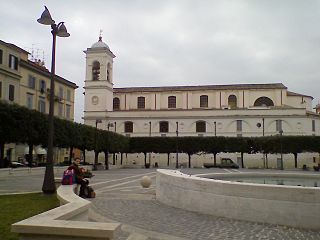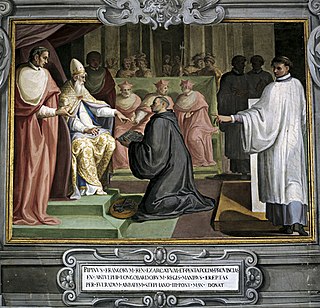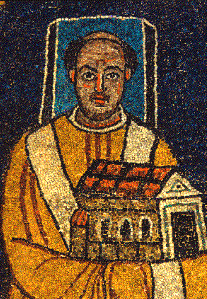
Pope Gregory IV was the bishop of Rome and ruler of the Papal States from October 827 to his death. His pontificate was notable for the papacy’s attempts to intervene in the quarrels between Emperor Louis the Pious and his sons. It also saw the breakup of the Carolingian Empire in 843.
Pope Stephen IV was the bishop of Rome and ruler of the Papal States from June 816 to his death. Stephen belonged to a noble Roman family. In October 816, he crowned Louis the Pious as emperor at Reims, and persuaded him to release some Roman political prisoners he held in custody. He returned to Rome, by way of Ravenna, sometime in November and died the following January.
Pope Sergius II was the bishop of Rome and ruler of the Papal States from January 844 to his death in 847. Sergius II's pontificate saw the Arab raid against Rome as well as the city's redevelopment.
Pope Valentine was the bishop of Rome and ruler of the Papal States for two months in 827. He was unusually close to his predecessor, Eugene II, rumoured to be his son or his lover, and became pope before being ordained as a priest. He was a nobleman and elected by nobility, which later became the custom.
Pope Eugene II was the bishop of Rome and ruler of the Papal States from 6 June 824 to his death. A native of Rome, he was chosen by nobles to succeed Paschal I as pope despite the clergy and the people favoring Zinzinnus. The influence of the Carolingian Franks on the selection of popes was then firmly established. Pope Eugene convened a council at Rome in 826 to condemn simony and suspend untrained clergy. It was decreed that schools were to be established at cathedral churches and other places to give instruction in sacred and secular literature. His involvement in the Byzantine Iconoclasm controversy was largely inconsequential.
Pope Paschal II, born Ranierius, was head of the Catholic Church and ruler of the Papal States from 13 August 1099 to his death in 1118. A monk of the Abbey of Cluny, he was created the cardinal-priest of San Clemente by Pope Gregory VII (1073–85) in 1073. He was consecrated as pope in succession to Pope Urban II (1088–99) on 19 August 1099. His reign of almost twenty years was exceptionally long for a medieval pope.
Pope Gelasius II, born Giovanni Caetani or Giovanni da Gaeta, was head of the Catholic Church and ruler of the Papal States from 24 January 1118 to his death in 1119. A monk of Monte Cassino and chancellor of Pope Paschal II, Caetani was unanimously elected to succeed him. In doing so, he also inherited the conflict with Emperor Henry V over investiture. Gelasius spent a good part of his brief papacy in exile.
Theodoric was an antipope in 1100 and 1101, in the schism that began with Wibert of Ravenna in 1080, in opposition to the excesses of Pope Gregory VII and in support of the Emperor Henry IV.

The Basilica of Saint Praxedes, commonly known in Italian as Santa Prassede, is an early medieval titular church and minor basilica located near the papal basilica of Saint Mary Major, on Via di Santa Prassede, 9/a in rione Monti of Rome, Italy. The current Cardinal Priest of Titulus Sancta Praxedis is Paul Poupard.

The Minor Basilica of St. Mary in Domnica alla Navicella, or simply Santa Maria in Domnica or Santa Maria alla Navicella, is a Roman Catholic basilica in Rome, Italy, dedicated to the Blessed Virgin Mary and active in local charity according to its long tradition. It is one of the best examples of the so-called "Carolingian renaissance" in Rome. It has been the titular church of Cardinal Marcello Semeraro since 28 November 2020.
The Constitutio Romana was drawn up between King Lothair I of Italy (818–855), co-emperor with his father, Louis the Pious, since 817, and Pope Eugene II (824–827) and confirmed on 11 November 824. At the time the election of Eugene was being challenged by Zinzinnus, the candidate of the Roman populace. Eugene agreed to several concessions to imperial power in central Italy in return for receiving the military and juridical support of Lothair. The Constitutio was divided into nine articles. It introduced the earliest known Papal Oath, which the Pope-elect was to give to an imperial legate before receiving consecration. It also restored the custom established by Pope Stephen III in 769 whereby both the laity and clergy of Rome would participate in Papal elections.

Saint Praxedes, called "a Roman maiden", was a saint and virgin during the 2nd century. She, along with her sister, Saint Pudentiana, provided for the poor and gave care and comfort to persecuted Christians and martyrs. Her veneration began in the 4th century and many churches have been dedicated to her.

The Diocese of Albano is a suburbicarian see of the Roman Catholic Church in a diocese in Italy, comprising seven towns in the Province of Rome. Albano Laziale is situated some 15 kilometers from Rome, on the Appian Way.

From 756 to 857, the papacy shifted from the influence of the Byzantine Empire to that of the kings of the Franks. Pepin the Short, Charlemagne, and Louis the Pious had considerable influence in the selection and administration of popes. The "Donation of Pepin" (756) ratified a new period of papal rule in central Italy, which became known as the Papal States.
Ingoald was the Abbot of Farfa from 815, succeeding Benedict. At the beginning of his abbacy he vigorously protested the policies of Pope Leo III (795–816), which had resulted in the abbey's loss of property. Ingoald complained about not only the—illegitimate, as he saw it—seizure of Farfa's lands, but also the application of dubious laws of Roman origin in a zone that followed Lombard law. While Ingoald also fostered close contacts with the Carolingian rulers of Francia and Lombardy, he resisted secular encroachments on the abbey's privileges as staunchly as he resisted papal ones. The rate of property transactions at Farfa seems to have peaked under Ingoald, but the surviving documentary evidence is far from complete.

The 1118 Papal Election was held to choose the successor for Pope Paschal II, who died in Rome on 21 January 1118, after an 18-year pontificate. Pope Gelasius II was elected as his successor. The election happened during the Investiture Controversy, a conflict between supporters of the Papacy and those of the Holy Roman Emperor. The election was held under the threat of possible violence due to the controversy. The Cardinal electors took refuge in the Benedictine monastery, S. Maria in Pallara, during the election. Within minutes of his election as pope, Gelasius II was attacked and imprisoned by the Frangipani faction, supporters of the Holy Roman Emperor. Gelasius managed to escape, but at the emperor's arrival with his army, he fled Rome and never returned.

The 1099 papal election following the death of Pope Urban II took place on 13 August 1099. Before his death, Urban had designated Cardinal Rainerius da Bieda as his successor. The cardinal-electors, with the consent of the lower Roman clergy, chose Rainerius, who, after a flight and over his considerable objections, accepted and took the name Paschal II. He was consecrated a bishop and crowned pope on the next day.

The 1086 papal election ended with the election of Desiderius, abbot of Monte Cassino as Pope Gregory VII's successor after a year-long period of sede vacante.

Caroline Jane Goodson is an archaeologist and historian at the University of Cambridge, previously at Birkbeck College, University of London. In 2003 she won the Rome Prize for medieval studies of the American Academy in Rome. In archaeological work, Goodson is most closely associated with the Villa Magna site in Italy where she has been field director since 2006.
Desiderius was a Roman Catholic Cardinal, and Cardinal-priest of the titulus of S. Prassede in Rome.











